Porcelain Insulator News
by Jack H. Tod
Reprinted from "INSULATORS - Crown Jewels of the Wire", January 1978, page 22
Dear Jack: I picked up this unusual two-piece insulator in a junk shop in
northern New York. It's dark brown in color.
I would appreciate any information you can give me on it. I also purchased
the only other insulator in the shop. It is an unembossed, glass threadless,
light aqua in color, with a mold line over the dome. It has a dome like CD-743,
but the base is like a CD-742.
Joe Geffert
Sayre, Pa.
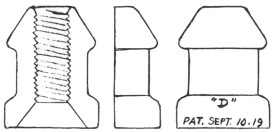
- - - - - - - - -
Dear Joe:
This is an "LF Clamp Insulator", and maybe you didn't get
the metal clamping parts that hold these porcelain halves together and serve
to mount it. We've had other inquiries about these insulators in the past and
have written it up several times in past issues of CJ -- the last tine in Nay
1974.
Most reporting have the "E" size, and yours may be the first "D"
(smaller wire) size I've had reported.
The correct patent date is 9-18-17, and
that is what is on the "E" sizes reported. If yours is marked
"SEPT.10.19" as you noted, that's an error marking. The patent
involved is #1,240,330, inventor Louis Fort, Jersey City, NJ.
These were manufactured and sold by the L. F. Manufacturing Co., 426-428 Hoboken Ave.,
Jersey City, N.J. The company was founded by Louis Fort, and he used "L
F" as a trademark on these and other insulators.
Jack

Dear Jack:
Got a news flash for you. We went driving last Sunday and passed through
Victor (N.Y.) by the insulator plant. And surprise -- a new name on the building
and sign.
So I stopped there today, and here's the info: ITE Imperial merged with
Gould, Inc. May 1, 1976. The name change became official on Dec 1, 1976: Gould,
Inc., Insulators Division. This is a Chicago-based company.
The ITE marking is being phased out, and I was told the new marking is being
used -- but only recently as none have been shipped yet.
The marking is only the logo and does not include the GOULD name (see
cut above from the company stationary).
The building signs went up about two weeks ago. Will have to watch for the
new marking on pin types.
Lew Hohn
Rochester, N.Y.
- - - - - - - - - -
Many thanks for this news. Wish someone living in the area would drop by the
Barberton (Ohio) insulator plant and see if Ohio Brass Co. has ever started
using their new logo marking on pin types. That logo was adopted in 1972, so
maybe it's on their pin types by now.
Jack
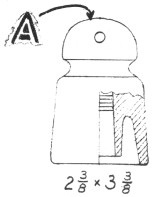
Dear Jack:
I've had this insulator for some time and haven't been able to find out
anything about it. It is white porcelain, and I think it might be foreign. It is
firmly glued to an iron pin.
The hole in the crown goes all the way through. The marking I've sketched is
off-center on the crown.
Tom Rogers
217 Springdale St.
Cumberland, MD 21502
- - - - - - - - -
Dear Tom:
This is most certainly a foreign item, and I know nothing about it. Maybe a
reader can help out with some info on it.
Many insulators have a hole through the crown such as your specimen, and it's
a bit frustrating that we can't learn for certain the purpose of the hole. We'll
print any factual answers readers can supply -- but not all the wild guesses.
Jack
Uneven baked clay spheres which were found in California desert area near an
old mine. They are brownish in color and only partly glazed. The inside of the
ball is smooth and the outside is scarified in a haphazard fashion.
No use of these objects has yet been suggested.
It was said that Chinese labor was used in mines in the area where these were
found and it may be that they are of this origin.
The drawing is 80% actual size.
There are 6 openings, placed on each side if the balls were cubes. There is
no sign of these openings having been used.
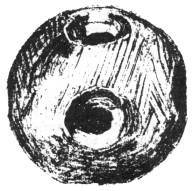
WHAT IS IT?
The above item was sent in by Gerald Brown (Two Buttes, Colorado).
We're all entitled to free guesses on these "whatisits", and after
considerable thought I figured this thing must be

But then I happened to view Gerald's drawing from the side and changed my
mind. Looks more like it's part of one of these:
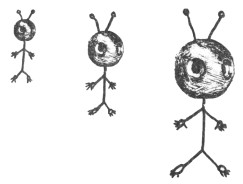

Dear Jack:
Reader Arthur Jones (CJ, Nov 1977, page 17) is lucky. The insulator he
picked up is from Poland. I have a pair just like it I picked up on a touring
and collecting jaunt in eastern Europe in 1976. Mine are marked as shown
above.
I think the mark between P Z is definitely a lightning bolt, and the bottom
numbers are the year of manufacture. I don't know anything about the
manufacturer etc. since just getting the insulators in these countries is a
difficult job because of the language difficulties.
In my travels I have been fortunate to pick up porcelains from Great Britain,
East Germany, Denmark, The Netherlands, Bulgaria, Yugoslavia, Czechoslovakia,
Austria, Norway, Sweden, Turkey and Poland. Also both porcelain and glass
insulators from Luxemburg, Belgium, Prance and Rumania. I even have a small
wooden insulator from Czechoslovakia.
I haven't had a chance to catalog any of these yet, but hope to get to them
next spring. In the meantime I am going to Colombia and Ecuador in December and
hope to collect a few insulators there.
Gene Calman
San Diego, Cal.
- - - - - - - - -
Dear Gene:
Many thanks for the info. Before you go to Poland again, brush up on your
Polish and ask them what the P Z means. My daughter speaks fluent French and
spent a year roaming France while in school in Paris. She brought me back some
real insulator jewels, but it was a real struggle until she learned the words
for terms such as insulator, electrical, crossarm, etc. -- all just as you
say.
It's no longer in doubt who wins the prize for traveling most to gather
insulator specimens, and also for the one with the most diversified collection
of foreign insulators. You win hands down as I see it.
Jack
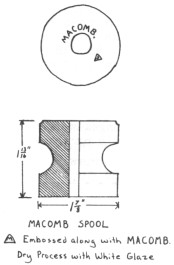
Dear Jack:
I have been collecting insulators for about 10 years now and enjoy both glass
and porcelain. I have been specializing in CD-145's for the past three years and
now have over 150 different with 96 of them being of Brookfield manufacture. My
collection of porcelain consists of different colors and shapes which appeal to
me. I have no ideas on any particular porcelain to specialize in. However, I
would like to have a complete set of MACOMB pin types. My interest in this line
of insulators is my reason for writing to you.
I know that the MACOMB line of pin types were those of early manufacture
(1911-1915) at Illinois Electric Porcelain Company. These insulators carry an
embossed "MACOMB." logo. According to your book, the Illinois Electric
Porcelain Company began using a Triangle-M logo somewhere around 1915. Later in
one of your supplements the MACOMB logo was confirmed as being early production
of Illinois. I can't see why this connection hadn't been brought to your
attention by some other collector earlier, but perhaps the insulator which I
have (above drawing) is unusual. (This is) a MACOMB spool, with white glaze,
which has the triangle-M embossed along with the usual MACOMB. Have you
run across any other MACOMB products marked this way, or is this unusual?
Enclosed with this letter you will find a light fixture piece of hardware by
MACOMB. You can have this one to add to your collection, since I have more of
them.
Tim Bagget
Clarksville, Tenn.
- - - - - - - - -
Dear Tim:
Yes, the entire Illinois marking bit is just as you have described it -- and
which is all clarified and put into proper order in my Second Edition of
"Porcelain Insulators Guide Book".
Regarding not having put this together by the time the original edition went
to printing in 1971, that's simple. It seems the only places I really went wrong
in published "facts" is when I did rely on what others
(including collectors) just told me word-of-mouth -- and especially those who
said there was more than one porcelain plant in Macomb, Illinois. As it turned
out, that info was all haywire. I preferred to wait until I had documented proof
of the marking situation -- and which came in big bundles later on, of course.
When I first got interested in porcelains in 1969-70, I knew absolutely nothing
about them, but I did know one heck of a lot about them by mid-1971 after a
year's research - and continued to learn more about them in later years.
In any event, yes we know of these items with the dual marking, but others
have the MACOMB embossed and the Triangle- M handstamped (incuse) on the pieces.
The identical #24 knob with dual markings was written up at least twice in the CJ
column, others have written about them, and others have shown me samples at
shows etc. Also, one collector reported having #334 surface-wiring cleats with
dual Illinois markings.
I certainly agree. Just collecting Illinois insulators alone would be a
winner -- and some collectors do just that. Not only did they make pin types,
but the variety of dry press standard porcelain and specialty items they made is
a real fun thing to chase down.
The Illinois company history is long and interesting -- and can be carried on
to the present by collecting the I.E. P., Line Material and McGraw items as
well. Some people do likewise with Locke or Pittsburg insulators, but I think
Illinois has then beat for an overall fun item to collect -- many items to chase
but not so many as to be impossible to house.
Many thanks for the MACOMB item. This is a standard porcelain "switch
base" (type for concealed wiring) as manufactured by all companies that
made "standard porcelain" See page 52 of ELECTRICAL PORCELAIN,
my new book just out last month.
Jack
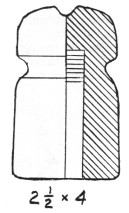
Dear Jack:
My sister just came back from Greece and found this porcelain insulator. I
have no porcelain books and don't know much about them.
I would like it if you or your fellow associates could try to identify it,
and I1ve enclosed a sketch and some info.
The top is flat with a small groove which doesn't come beyond the rounded top
edges. The pin hole is smooth part way up but then has annular rings (not
threads) in its top.
Dave Kolbe
291 Henry St.
Manchester, CT 06040
- - - - - - - - -
Dear Dave:
Sorry, but all insulators from that part of the world are Greek to me.
Although it may have been used in Greece, it might have been manufactured
elsewhere. As with crossarm insulators used in all parts of the world other than
North America, the small, serrated pinhole is for cementing onto steel pins.
Jack
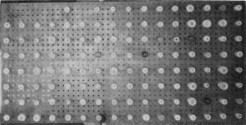
A collection of STANDARD porcelain insulators, (108), collected and mounted
by Walter Plank, La Junta, Colorado. They mostly marked by brand names and
sizes.
Submitted by Gerald Brown.
Robert E. (Bob) Reyburn, 569 Hawthorne St., Ontario, CA 91764, N.I.A. #1584,
bas been in the electrical power game all his life and has one of the best
collections of power insulators and apparatus around. Not surprising, since he's
been gathering in these artifacts since before many current collectors were even
born. Bob sent us photos and information on just one of his many interesting
specimens.
Pictured immediately below are what the old catalogues referred to as
"Fuse Holders".
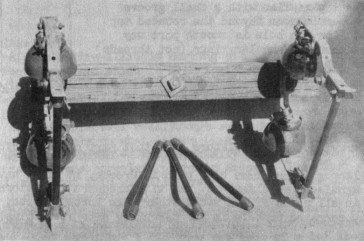
The porcelain insulators are U-705's made by Ohio Brass Co., and they are
cemented onto the parts of the forged steel mounting brackets as shown. Bob says
this is a model of about 1900 vintage and that old-timers in the field say these
were installed before 1913.
The fuses are made of cobalt blue, hollow, porcelain tubes with bronze end
caps. The fuse wire is inside the tube. The bronze end caps are marked
"BOWIE SWITCH CO.", and Bob would like to hear from any reader who
knows something about this old company.
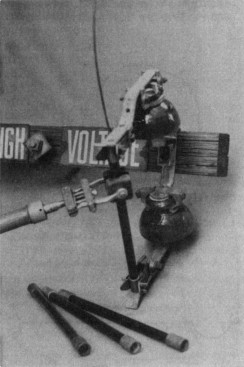
The photo at right shows more clearly how the pin types are used in the
bracket assembly. Note also the end of the special hot-stick tool used for
replacing blown fuses on energized lines. This has a 5' stick, and Bob calls it
a "Fuse Grabber"
And just in case you didn't notice the other goodies here, the "HIGH
VOLTAGE" sign is just one of several versions Bob has of the old
porcelainized signs in his collection.
This mickey-mouse scheme of brackets and pin types came to an end in the
1930's with the advent of one-piece porcelain tubular fuse-holders, developed
and marketed by Lapp. When you see one of the ones like Bob has, you're looking
at a real antique.
Bob doesn't just haul things home and let them lie around in a heap. He has
everything carefully catalogued and spends considerable effort to learn all he
can about each specimen -- who made it, when, the catalog number, its exact use,
etc
He also is an ardent photo hobbyist, and every item is filed with the most
beautiful color photos I've ever seen of insulator specimens. Too bad we can't
print some of those color photos. Each photo is accompanied by all the data on
each item in the photo.
Bob had a fine exhibit prepared for the Oroville show but had to cancel
because of illness in the family. Maybe we can see some of his items on exhibit
in Reno this summer.
| 